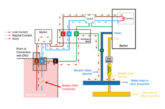
This article from the team at NICEIC looks at the provision of electrical energy storage systems (EESS). It focuses on the operational modes that may be employed and the means by which the storage media is connected to the host installation and embedded generation, if any.
An increased focus on energy efficiency, in conjunction with the wider availability of cost-effective small-scale generation and the significantly reduced availability of new attractive Feed-in Tariffs, has seen an increase in the installation of local electrical energy storage systems (EESS) at a wide range of properties, including domestic premises.
This is reflected in Amendment 2 of BS 7671, which has introduced a new Chapter 82 – ‘Prosumer’s low-voltage electrical installations1’ which contains requirements and recommendations relating to the delivery of locally generated energy into the public supply network and/or for use to supply loads locally.
The installation of an electrical energy storage system (EESS) provides a means to store surplus energy generated locally:
– either for use within an installation at some later time, or
-for export to the public supply network for financial gain.
An EESS can also be employed to store energy taken from the public supply network where there is no local generation capacity. It can also provide a reduced reliance on the public supply network.
Nature of the system
An EESS may be designed and built for a particular application or it may be assembled from a range of component parts to provide the desired functionality.
One of the most critical aspects of any EESS is how it is connected to the sources of supply and loads. Connection may be made by either:
-AC-coupling – where both input and output operate at 230/400 V; 50 Hz AC. This is beneficial for the direct supply to AC loads within the premises, but also requires the installation of an inverter and charge control equipment to convert the supply to the storage batteries to DC for charging purposes and from DC to AC to supply AC loads (see Fig 1).

Where a battery storage system is added to an existing solar PV system it is likely that it will be AC-coupled as so doing will be easier and cheaper than adding a DC-coupled system. However, in the longer term, a DC-coupled system will offer higher operational efficiency and greater flexibility.
-DC-coupling – where both input and output operate using DC. This allows for the charging of batteries via a DC/DC convertor – with significantly higher efficiency than an AC supply via inverter/charge controller as there is only one stage of inversion, minimising losses (see Fig 2). It also allows for the provision of a direct supply of DC loads within the premises. Although not commonly employed, this is likely to become more commonplace in the future as installations contain more distributed DC circuits.

A DC-coupled system is likely to be installed in the majority of new combination PV/energy storage systems due to its higher intrinsic efficiency.
Operational modes
A number of operational modes are available to meet a diverse range of customer needs. These modes of operation will directly influence design considerations, equipment selection and system complexity. A customer may want an EESS installed in their premises for a number of reasons, including:
-Time shifting – this is the ability to make most effective use of any excess self-generated energy within an installation at a time when it is needed, or when the embedded generation is not producing energy, or is minimally productive. An example of this would be a PV system at night and on dull days. Fig 3 shows an example of how such a system may operate over a 24 hour period.

-Value optimisation – where an installation is supplied on a variable tariff, energy can be bought at lower cost (off-peak) times and stored locally for use as an alternative to the public supply at times of peak demand/highest cost employing time-shifting. Such a system can be employed in premises where there is no embedded generation capacity and can provide a significant saving over time in some cases. Fig 4 shows a typical arrangement for such a system.

-Alternative supply – the ability to provide a back-up source of energy for a complete installation, core parts of the installation, or for those parts for which continuity of supply is necessary (see Fig 5). Where a system is employed to provide an alternative supply the design must ensure adequate availability of capacity to meet the expected energy demand.

An EESS operating in island mode – that is, where supply is maintained from embedded generation or energy storage although the supply from the grid has been disconnected, cannot rely on the earthing arrangement provided by distributor when running independently of the DNO supply (551.4.3.2.1). This does not mean, however, that the Distributor’s means of earthing must be disconnected during such operation.
Energy Recommendation G99 Requirements for the connection of generation equipment in parallel with public distribution networks on or after 27 April 2019, published by the Energy Networks Association (ENA), requires provision of the following when an EESS operates in Island mode:
-An earth electrode system independent of the earthing arrangement for the grid connection. Any such electrode(s) must have a sufficiently low impedance to allow for the correct operation of protective devices/equipment.
-A means to break all poles of the supply, including the neutral, to prevent transfer of any phase or neutral current produced by the embedded generation from passing into the public distribution network.
-A means to connect the neutral and earth of the embedded generation just after, but at substantially the same time that, all poles of the supply are disconnected. This is to prevent incorrect operation of RCDs within the installation.
-Grid independent operation – to provide reliability of supply with only self-generated energy employing for example time-shifting (as described previously). Any grid independent system must be provided with an earth electrode system having a sufficiently low impedance to allow for the correct operation of protective devices/equipment.
-Additional supply capacity – to work in conjunction with an existing grid supply to make possible expansion of the electrical load of the premises whilst avoiding the need to have a potentially costly upgrade to the incoming supply arrangement. Such a system may be particularly useful to small businesses whose energy usage has increased as their business expands.
-Peak lopping – similarly to the provision of additional energy supply capacity, embedded generation/storage capacity can also be used to supply any peak demand exceeding the agreed public supply capacity, so avoiding costly financial penalties (see Fig 6).

Summary
Due to an increased focus on energy efficiency, particularly in conjunction with the wider availability of cost-effective small-scale generation, there has been an increase in the installation of local electrical energy storage systems (EESS).
This article has looked at the provision of electrical energy storage systems (EESS) and has described a range of operational modes that may be provided by an EESS. The means for connecting an EESS into an installation has also been considered.
To get more details about NICEIC registration, click here








